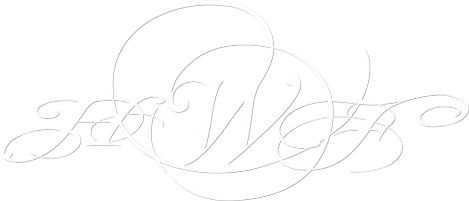







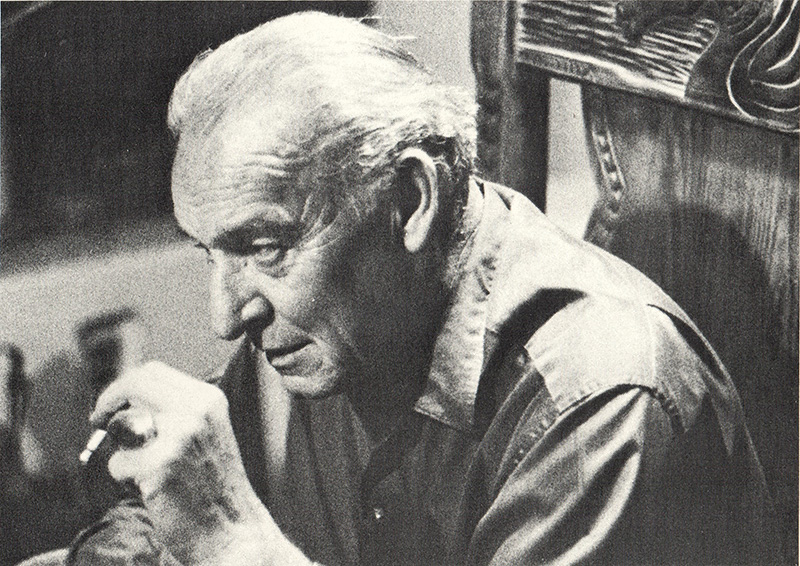
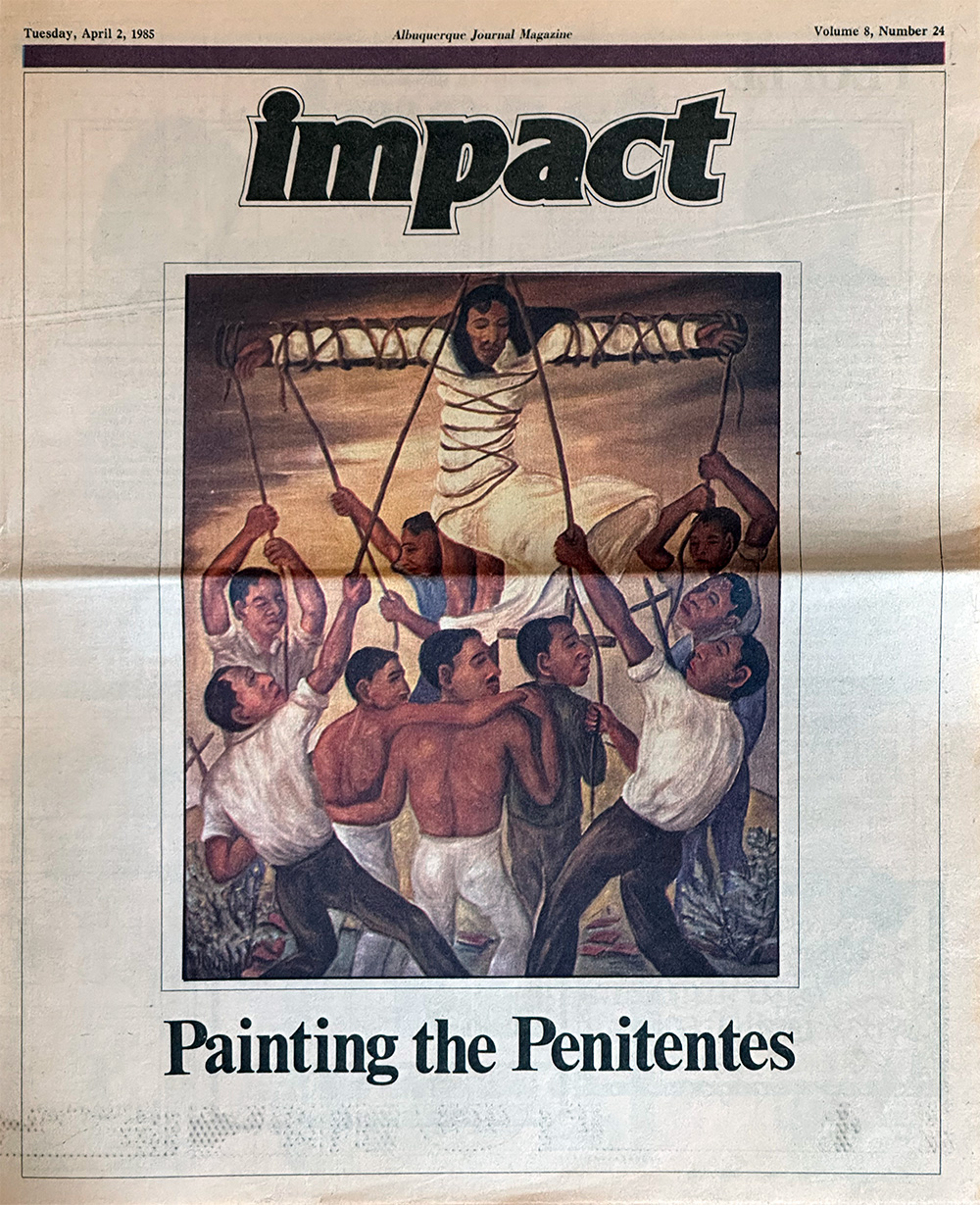
Source: Impact, Volume 8, Number 24 • Albuquerque Journal Magazine
Tuesday, April 2, 1985 • By Tricia Hurst
For 45 years, Isaac Lawrence Udell was a small town physician with a big heart and a nearly hidden talent. After a childhood in Michigan, Colorado, and Raton, N.M., where his parents ran a bakery, Udell arrived in Taos in 1924. He was 20 years old and a chiropractor by education. Because Northern New Mexico needed physicians and because Udell had briefly attended medical school in Colorado, the state permitted him to practice medicine. And practice he did. People came from three surrounding states to see kindly and gentle Doc Udell. Often his patients checked into local motels and simply waited their turn. Udell’s story, which has been told before, is a classic one: Patients paid him whatever they could (eggs, chickens, and even a horse once), and whenever they could (sometimes never).
Yet there is another, special side to Udell’s story that has seldom been told. A big, white-haired, teddy bear of a man, Udell possessed an avocation that nearly equaled in passion his need to care for people: Painting the stages of the Penitente ritual. Udell was mostly a self-taught artist. During his early years in Taos, he developed a primitive painting style all his own. After he gained the trust of Indians and Hispanics in the area, he began to paint them. The Penitentes, a secretive religious group involved in Holy Week ceremonies that included self-flagellation and even crucifixion, especially intrigued him. Udell befriended the Penitentes and treated them in his office.
In turn, the Penitentes allowed him to witness their extremely private rituals in the isolated villages of Norther New Mexico. During the 1930s, Udell completed 13 large paintings of the Penitentes. A few years later, he sold the paintings to Helene Wurlitzer, a wealthy woman who lived in Taos part of the year. After Mrs. Wurlitzer’s death in 1963, the paintings became the property of the Wurlitzer Foundation, a Taos organization that supports the arts. The foundation maintains, near downtown Taos, an adobe retreat center for writers, artists, musicians, choreographers and others in the creative arts. For many years, the paintings remained at the Wurlitzer Foundation. Some of the paintings hung on display, but most were kept in storage. Many years ago, Udell’s Penitente works went on a tour in this country and Europe. Yet because the Wurlitzer Foundation is not open to the public, the paintings for the most part remained unknown. Udell did other paintings, and some now reside in private collections. He enjoyed sitting at his easel, his method of reaction from a frantic life. Not only did he maintain a busy medical practice, but after his marriage broke up, Udell also reared his fife children almost single-handedly. A modes man, udell did not aspire to display his work in the galleries of Taos, a town of artists. Nor did he seek criticism of applause. yet his work is alive with the truth of his portrayal of human faith and experience. He was deeply religious in his own way: He worshiped the land, the earth and the great outdoors. But most important, he was sensitive to his subject matter, aware and respectful of the sacredness of the Penitente Brotherhood. He once wrote of the Penitentes: “I can ask only, at the expense of appearing sentimental, that the story of the Penitente Brotherhood be received with understanding, charity and human kindness, in return for a knowledge of a people whose heritage is rich in bravery and daring, whose faith is deep and unquestioned, and whose conviction is sure.”
THE NEW MEXICO Penitentes that Doc Udell painted have a history that can be traced to the late 1700s. At that time in the Southwest, there was an insufficient number of clergy for the Spanish settlers here. In the absence of the priests of friars, colonists were left to their own means of worship. Some chose to emulate the lives of the saints and the Passion of Christ, and soon founded their own order: Los Hermanos Penitentes, or the Penitent Brothers. The Penitentes, as the members of the Brotherhood are commonly referred to, still exist in areas of the Southwest. The Brotherhood that Doc Udell come to know, practiced, with some modifications and variations, the Passion of Christ during the days of Lent. There was nothing new in their practices that Udell saw. Self-flagellation had been used for centuries as atonement for sin. At one time in history, self-flagellation was a privilege permitted only to martyrs, godly men and kings. The members of the Brotherhood who practiced the ritual were neither a segregated clan nor class. They were the descendants of the Spanish colonists who brought a culture to the New World at a time when Spain was at the height of her wealth, power and glory. Udell found the Penitentes to be normal men who had normal occupations: ranchers, sheepherders, storekeepers, mechanics, clerks, teachers. They lived, he discovered, common, everyday existences. Only during Lent, a time for penance and atonement for wrongdoing were they in evidence as Los Hermanos Penitentes. Their processions were once public. But with the advent of the Anglo, especially the “touring American public,” the Penitents began to suffer criticism for their practices, which many outsiders considered harsh. Over the years, the Penitentes withdrew more and more. Their rituals became closely guarded secrets. There was a time when the Catholic Church frowned upon the Brotherhood. However, most priests worked out with their Penitente parishioners an acceptable relationship. Then, in 1947, by decree of Archbishop Edwin V. Byrne, all Penitentes were recognized by the church with one stipulation: that their practices become less severe.
DOC UDELL’S PAINTINGS capture the full range of the Brotherhood’s Holy Week activities from beginning to end. His Official Seal of the Order shows an aspiring initiate receiving three crosshatched cuts on each side of his spine. The rite was usually performed by the sangrador, the bloodletter. The cutting was usually done with a piece of flint or obsidian, not sharp enough to cut too deeply, but to cut broadly, leaving a “good” scar. The Penitente wore this scar much as a lodge member might wear a pin in the lapel of his coat, although it was rarely, if ever, seen. Beginning the Procession depicts members taking down the crosses from a Morada, or Brotherhood house, in preparation for beginning the ceremony. The crosses, each weighing between 300 and 800 pounds, were cut in late February or early March when the sap began to rise. The processions of the Penitentes occurred at almost any time of the day or night during Lent. The procession wound its way from the Morada to Calvario, a cross usually located on a hill, or to the nearest Campo Santo, or cemetery, where the pilgrims stopped before each grave to offer prayers. In many Penitente processions, one of the brothers dragged the Carereta Del Muerto, or death cart. The Penitentes often had loaded the carts with stones. And atop the stones rode La Muerte, death herself, a carved skeleton draped in black and carrying a bow with a red-tipped arrow. Though they followed a procession, women had no part in the drama. Their chief role was to bring the men food and drink in the Morada while they prepared for the procession and after it ended. In every procession, the Hermano Mayor, or chief brother, carried the crucifix. The Rezador, or reader, chanted form a small hand-written book of ritual. The cross-bearers wore black hoods over their heads as a form of self-effacement.
At the Calvario, the whippers in humility prostrated themselves before the cross, where they remained while other Penitentes read prayers and sung chants. The brothers sometimes administered an occasional encouraging lash to a faltering or weary member. Their disciplinas, or whips, were made of touch, sharp-edged yucca fibers. Every member vowed to accept self-flagellation at least once after initiation. The ritual of crucifixion, though varying from year to year, climaxed all Penitente Lenten ceremonies. Often only one crucifixion was held for several participating communities or neighboring villages. The Penitentes sound the chosen subject to the cross while it lay upon the ground. Nailing rarely occurred: In Udell’s Penitente Crucifixion, as seen on the cover of Impact, the subject is lashed to the cross. However, one story has it that Udell, after first arriving in Taos, treated Penitentes for nail wounds. Those bound remained conscious for only a matter of minutes, since circulation was impaired. When the man on the cross lost consciousness, the cross was lowered and the procession returned to the Morada. On occasion, a brother died during a ceremony - from loss of blood or exposure. The announcement, as seen in Udell’s Death Came During Penance, was made by leaving some article of the deceased’s clothing, usually his shoes, on the doorstep of his home.
NO ONE MISTOOK Udell’s creations for the works of Van Gogh or Gauguin. Udell’s object was, after all, to tell a story - the story of the Penitentes. Those people who did view his Penitente paintings were invariably impressed and often deeply moved. When the paintings were sent on their single tour, a catalog was printed to travel with them. Init, renowned artist Ben Shahn, who had come to know Udell while Shahn was teaching in Colorado wrote this: “These Penitente paintings of Udell’s stand on their own feet as a great and moving epic. However weak they are technically - at the they are that - I prefer them a thousandfold to the technically glib and humanly empty work which we see in such profusion today”
OF HIS PENITENTE works, Udell once said: “No claim is made for the artistic accomplishment in the paintings. If they merit claim as an historical documentation of a phase of America, if they give pleasure and insight to the observer (without any sense of exploitation of things sacred), then a gift will have been returned to a land and a people I cherish, and whose memory is a part of my daily life.” Isaac Udell was 80 when he died this past Feb. 20 [1985] in Phoenix, where he had retired in 1970. His ashes were spread over the Taos Valley and the sacred Taos Mountain, a land he loved and a land where the people he loved lived.
[End of "Impact" article]
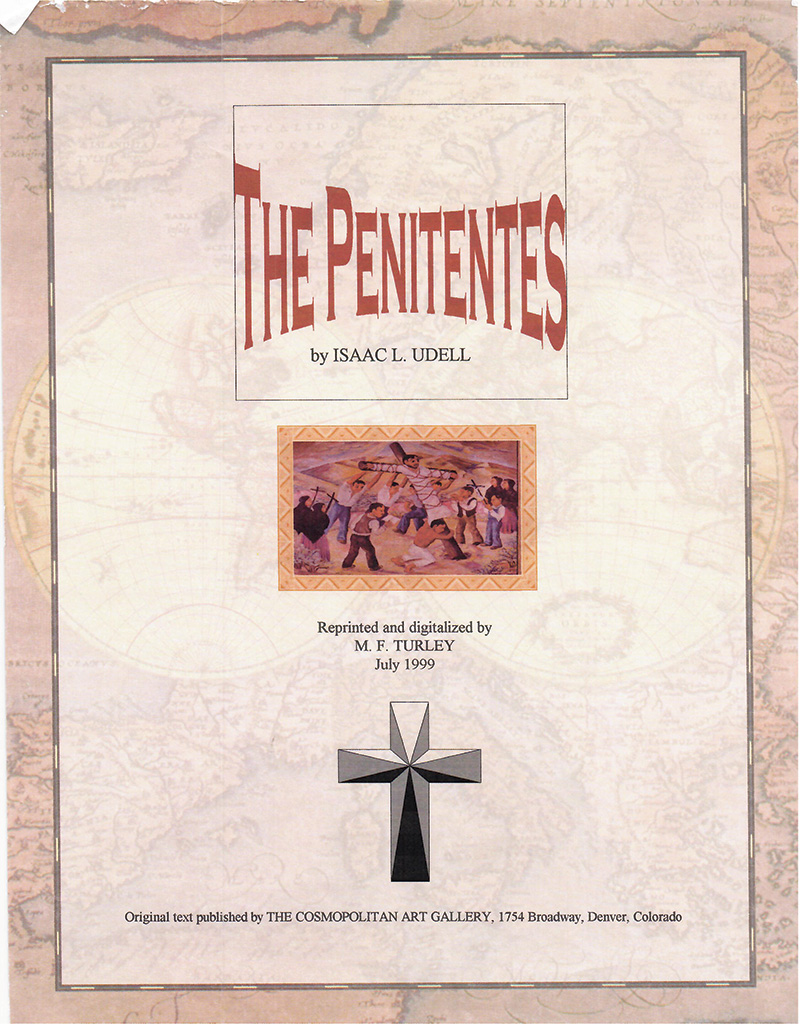
By Isaac L. Udell • Boulder, Colorado August, 1950
By the beginning of the sixteenth century all of Europe enjoyed a peculiar unity under the name of Christendom. Most peoples owed allegiance and obedience to church and empire. The church served the spiritual needs of the people but it also exercised vast political power. Men were born, lived, and died in the ritual of the church. Religion was an all-powerful influence in the mind and action of the time. Not the least of the churches’ responsibilities was education. One phase of education which reached the masses was carried on by the Franciscan Friars, a mendicant order, which went from home to home telling the stories of the lives of the Saints. In this way the Saints came very close to the people and were integrated into their daily lives.
These Mendicant Franciscan Friars were by papal charter known as the Third Order of Saint Francis. And it was these Friars who most often accompanied Spain’s gentlemen explorers and men of arms on their expeditions. So it was that these Franciscan Friars accompanied Coronado and his colonists to the New World and to that region which is now New Mexico. Coronado and his men and Friars with some six hundred colonists arrived at San Juan, an Indian Pueblo on the Rio Grande river about mid-way between the modern towns of Taos and Santa Fe. Coronado, facing winter without adequate food or shelter for his band, asked self-flagellation of his followers with a two-fold purpose. First, as a form of thanksgiving for having arrived this far on his journey safely and, secondly, as a form of supplication to the Deity to aid and provide for them in this wild new land.
Once the colonists were established Coronado was ready to explore farther inland and eventually return home. Some of the Friars accompanied him, some went in search of new souls to convert, many were killed by hostile Indians. The eventual result was that the colonists were at last left without benefit of clergy. In this way these men who could not conceive of life without the church, not being able to celebrate the Mass, found it necessary to make use of that phase of religious legend they did know. They had learned of the lives of the Saints and of the Passion of Christ from the Franciscan Friars. These things they understood and could emulate. Hence it may be said that Los Hermanos Penitentes derive indirectly, if not authoritatively, from the Third Order of Saint Francis. The Third Order having been known as a Penitente order and described as a vast lay confraternity—practicing penance and charity among the poor.
Los Hermanos Penitentes, The Penitent Brothers or simply Penitentes as the members of the brotherhood are commonly referred to, are known in modern times to the southwestern area of the United States. Their practices are a fragment of another and medieval civilization which has survived as the native in this rather stark and brooding land has clung uninterruptedly to his religious heritage to sustain himself. The ordeal of self-flagellation is nearly as old as man. There is nothing new in its use as atonement for sin. At one time in history it was a privilege permitted only martyrs and godly men, even kings.
The brotherhood as it exists today, with many modifications and variations reenacts the Passion of Christ each year during the days of Lent.
The members of the brotherhood who practice the ritual today are neither a segregated clan nor class. They are the descendants of the Spanish colonists who brought a culture to the New World at a time when Spain was at the height of her wealth and power and glory. Today they are referred to as Spanish-American and their culture is the Spanish-American culture of the great southwest. They are normal men who go about their daily businesses as ranchers, sheepmen, storekeepers, mechanics, clerks, teachers, etc. They live common everyday existences. Only during Lent, a time of penance and atonement for wrongdoing are they in evidence as Los Hermanos Penitentes. Their processions were once quite public but as the Anglo came, and especially with the advent of the “touring American Public” they suffered many indignities from lack of sympathy and understanding. Over the years they have with drawn more and more into the secrecy of the land. Time, was, too, when the church frowned upon the brotherhood and ex-communication as the penalty for openly avowing membership. However, in 1947, by Papal decree, they (being all Catholics) were accepted into the church, as Penitentes, with the stipulation that their practice become less severe. Their membership is growing smaller and smaller. Soon Los Hermanos, in all save the deep religious spirit which first moved them will pass into history as another chapter of the great and varied American scene.
The years I spent in New Mexico were formative, early adult years. After having spent a childhood in a constant state of “moving” from one place to another, over the length and breadth of the United States, New Mexico seemed the land of my home. There I felt that I “belonged”. I found a certain peace, security, and vital interest. I liked the people. They seemed a part of what I sought. I lived and worked with and among them. The land and the people became a part of me, a rich and fulfilling part. New Mexico was my home, the first place as such that I could claim as mine.
When circumstance removed me from New Mexico I lived with a terrific and terrifying nostalgia. The land was within me but I was without the land. My compromise was logical. I must create things of the land to keep with me as tangible evidence that it did exist.
I wrote, for my own satisfaction, of the land and people. I carved rough Santos for my walls. I made crude drawings of the life there. These things, however, did not seem a large enough gift to return to the land which had given so much to me. It was then, with a certain doubt in my own ability but with a strong conviction that it should be done, that I began the series of Penitente paintings. I felt that represented in this segment of faith was the one constant which had influenced the minds and culture of a goodly portion of the Southwest. Aside from the Indian culture it was the one uninterrupted thread of heritage and it was the land. The paintings were a fragment of life there which I could keep within my grasp.
Some thirteen or fourteen months went into the paintings. A few people saw them in progress and were more than interested. Gradually and over a period of some ten years, more and more people have come to see the paintings and to acquire first hand information of Los Hermanos Penitentes. I have been asked to write articles, research papers, and to lecture on the subject. All of which I have kept to a minimum. But at last I have been persuaded that my experience should be shared.
In this first publication of a work which was originally not intended for publication, I can ask only, at the expense of appearing sentimental, that the story of Penitent Brotherhood, be received with understanding charity and humane kindness in return for a knowledge of a people whose heritage is rich in bravery and daring, whose faith is deep and unquestioning, and whose conviction is sure.
No claim is made for the artistic accomplishment in the paintings. If they merit claim as an historical documentation of a phase of Americana, if they give pleasure and insight to the observer (without any sense of exploitation of things sacred) then a gift will have been returned to a land and people I cherish, and whose memory is a part of my daily life.
- I. L. UDELL • Boulder, Colorado August, 1950
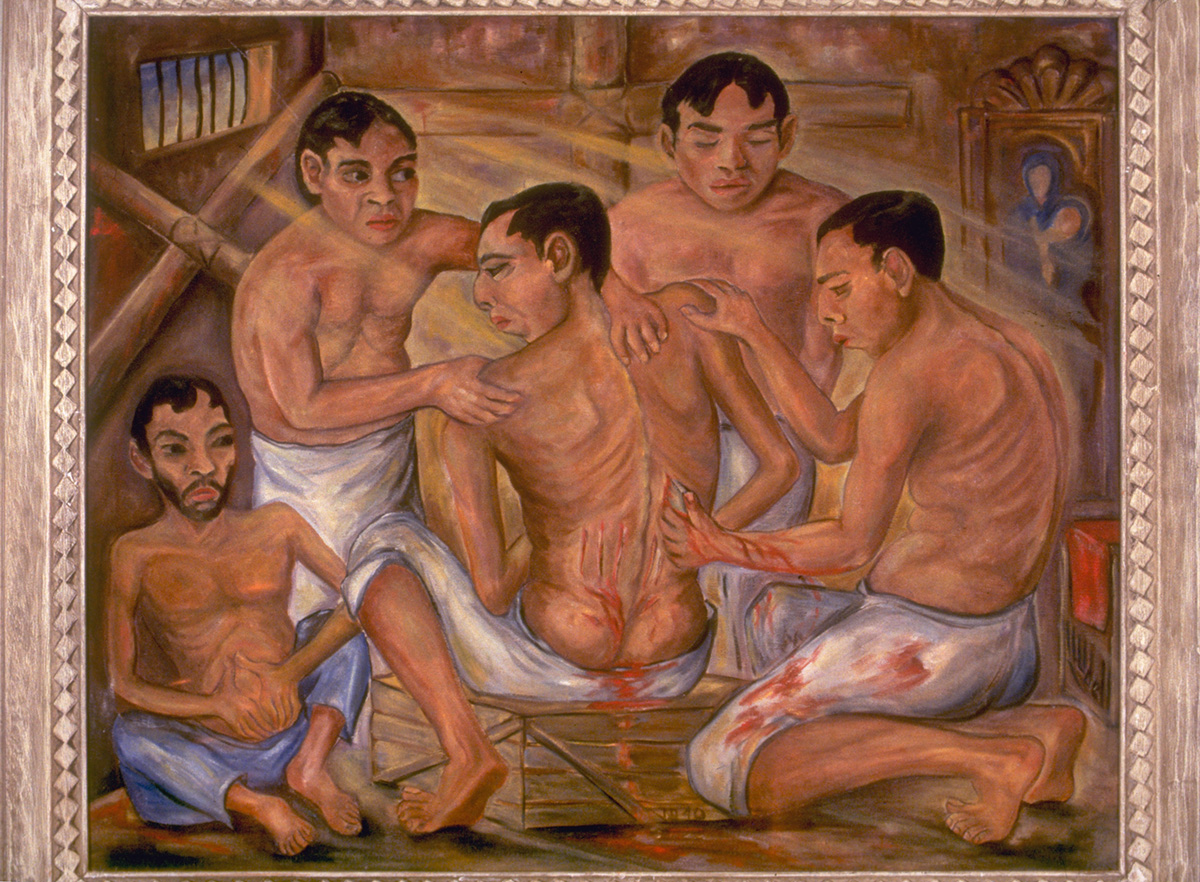
1. Official Seal of the Order The seal of the order is cut upon the back of the aspiring initiate. The seal consists of three cuts on each side of the spine in the region of the kidney and is then usually “cross-hatched” leaving scars which crudely resemble crosses. This rite is usually performed by the Hermano Mayor, the chief brother, or by the Sangrador, the blood-letter. Although the movements of the operator may appear unskilled, a certain amount of skill is required to complete the performance without permanent injury from severed nerves and muscles. The cutting is usually done with a piece of flint or obsidian, not sharp enough to cut too deeply, but to cut broadly leaving a “good” scar. The penitent wears this scar much as a lodge member wears a pin in the lapel of his coat, although it is rarely if ever seen.
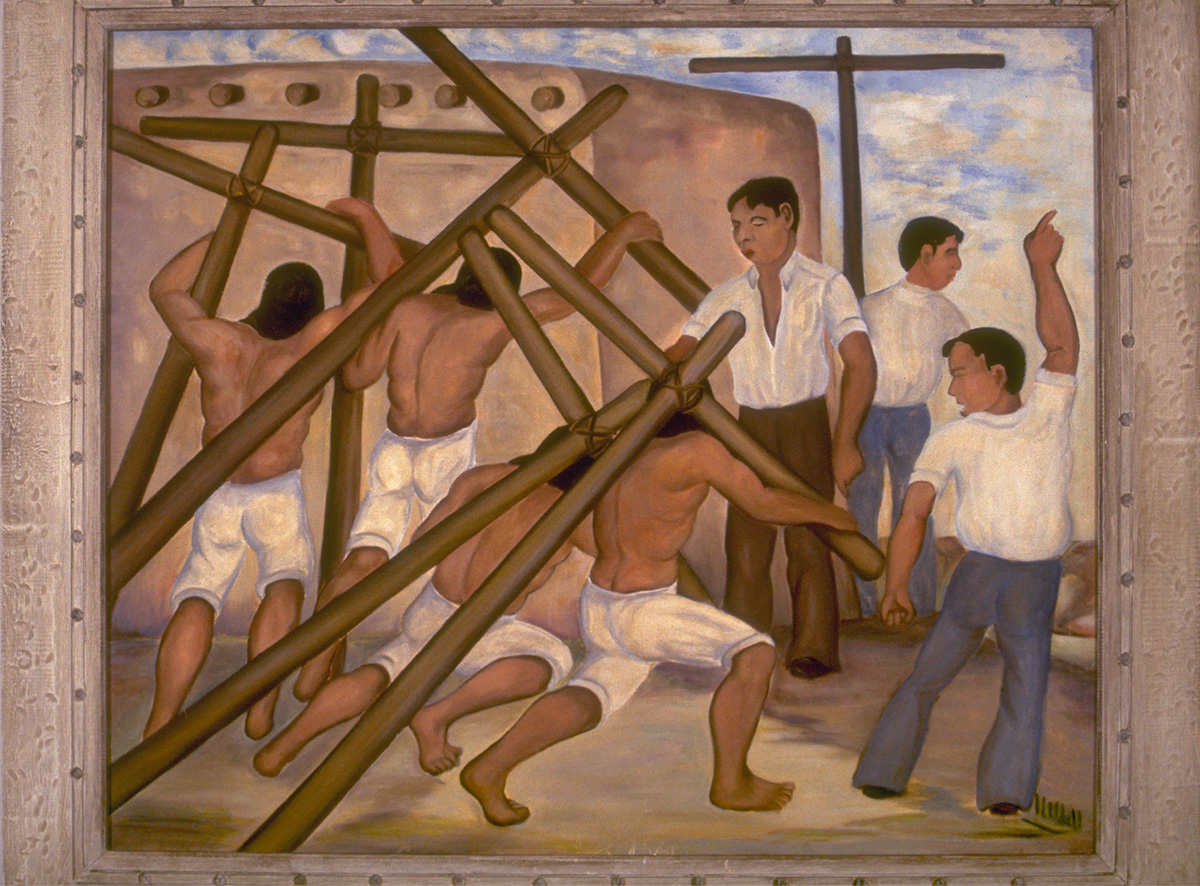
2. Beginning the Procession Throughout the year the huge crosses are dismantled and are stored within the Morada. During Lent, however, when they are so much in use, one may see them leaning against the Morada walls between processions. They are worn smooth from so much handling, and catch the sun and reflect it brightly, or, seen at night, if there is a moon, they seem to glow strangely.
The timbers for the crosses are cut in late February or early March, when the sap begins to rise. Cut at this season the bark slips off easily, leaving the poles with a hard glazed resinous surface, almost as though they were varnished. Here some of the brothers are seen taking the crosses down preparatory to beginning a procession.
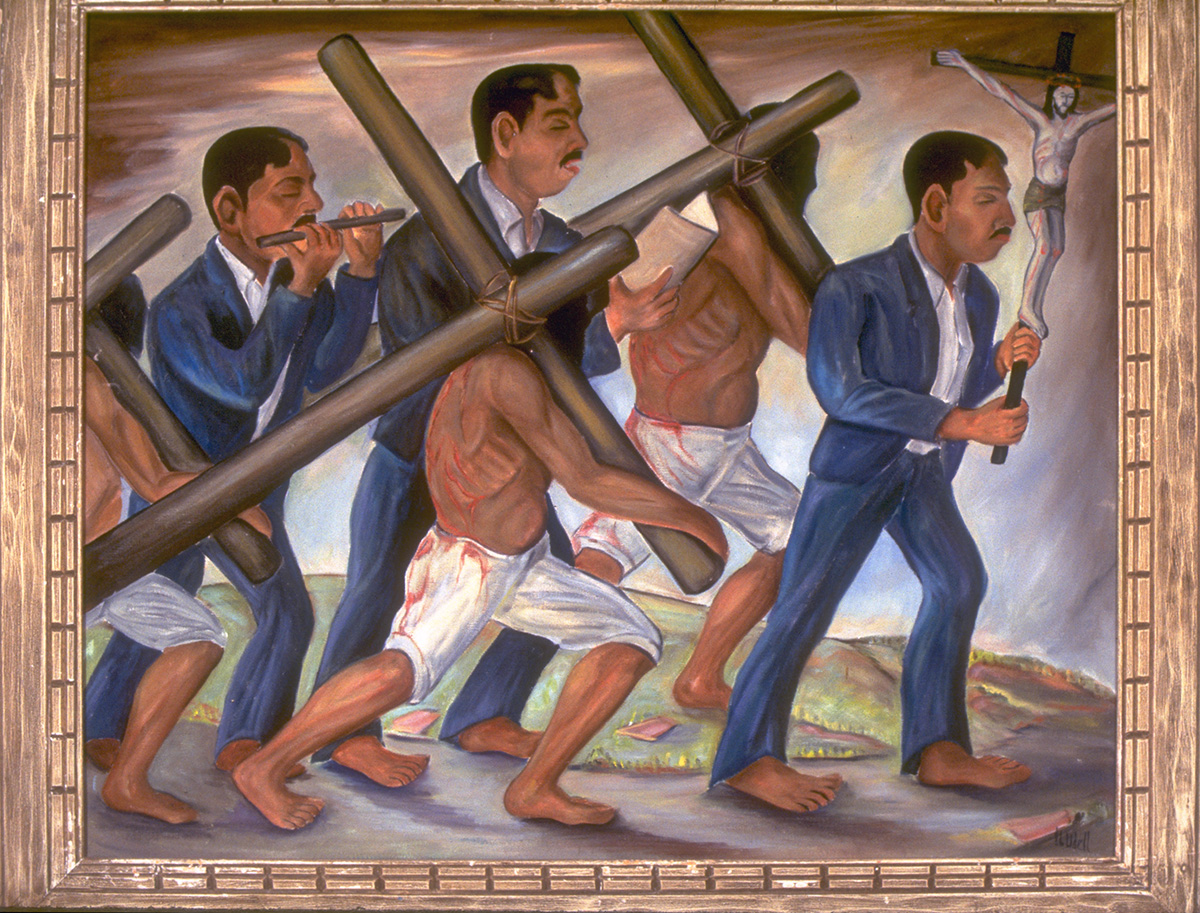
3. Penitente Procession The processions of the Penitentes may occur at almost any time of the day or night during the days of Lent. The processions are composed of officers of the order, the cross-bearers, and the whippers (often a gallery of men, women, and children follow). Occasionally a lone exalting whipper is seen. The processions wind their way from the Morada, the brotherhood house, to calvario, a cross located, usually on a hill, which may be a distance of from a fraction of a mile to several miles, or to the nearest campo santo, the graveyard, where the pilgrims stop before each grave offering prayers.
In every procession the Hermano Mayor, the mayor brother, who carries a crucifix, the Rezador, the reader, who chants from a small hand-written copy book of ritual, and the Pitero, the flute-player, who plays the pito, a reed flute, is to be found.
The cross-bearers wear black hoods over their heads as a form of self-effacement. The crosses weigh from three to eight hundred pounds and often have stems over twenty feet long. There are usually attendants for the cross-bearers to aid them should they fall beneath the terrific weight and to urge them on should they falter.
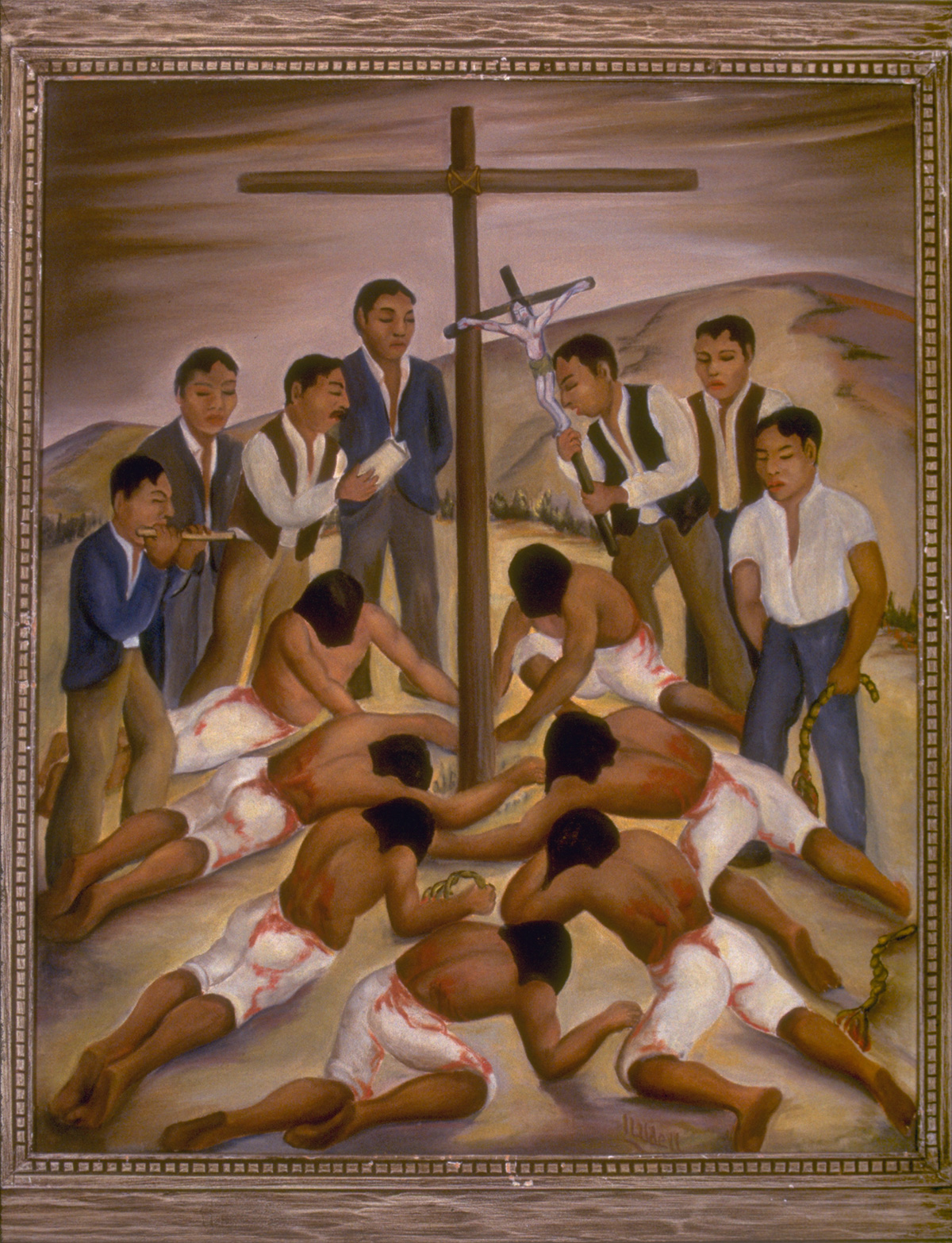
4. Calvario The Penitent procession having arrived at Calvario, the whippers in humility, prostrate themselves before the Cross where they remain while prayers are read and chants are sung.
It should not be understood from the painting that the Penitentes lash one another. Here a Brother is simply holding a disciplina dropped by one of the flagellants. An occasional “encouraging” lash is sometimes administered to a faltering or weary member. Each penitent measures his ordeal according to the dictates of his own conscience—atonement in proportion to his own interpretation of his wrongdoing.
After the ceremony at Calvario the procession makes its way back to the Morada where it is met by a group who have remained to welcome the pilgrims back.
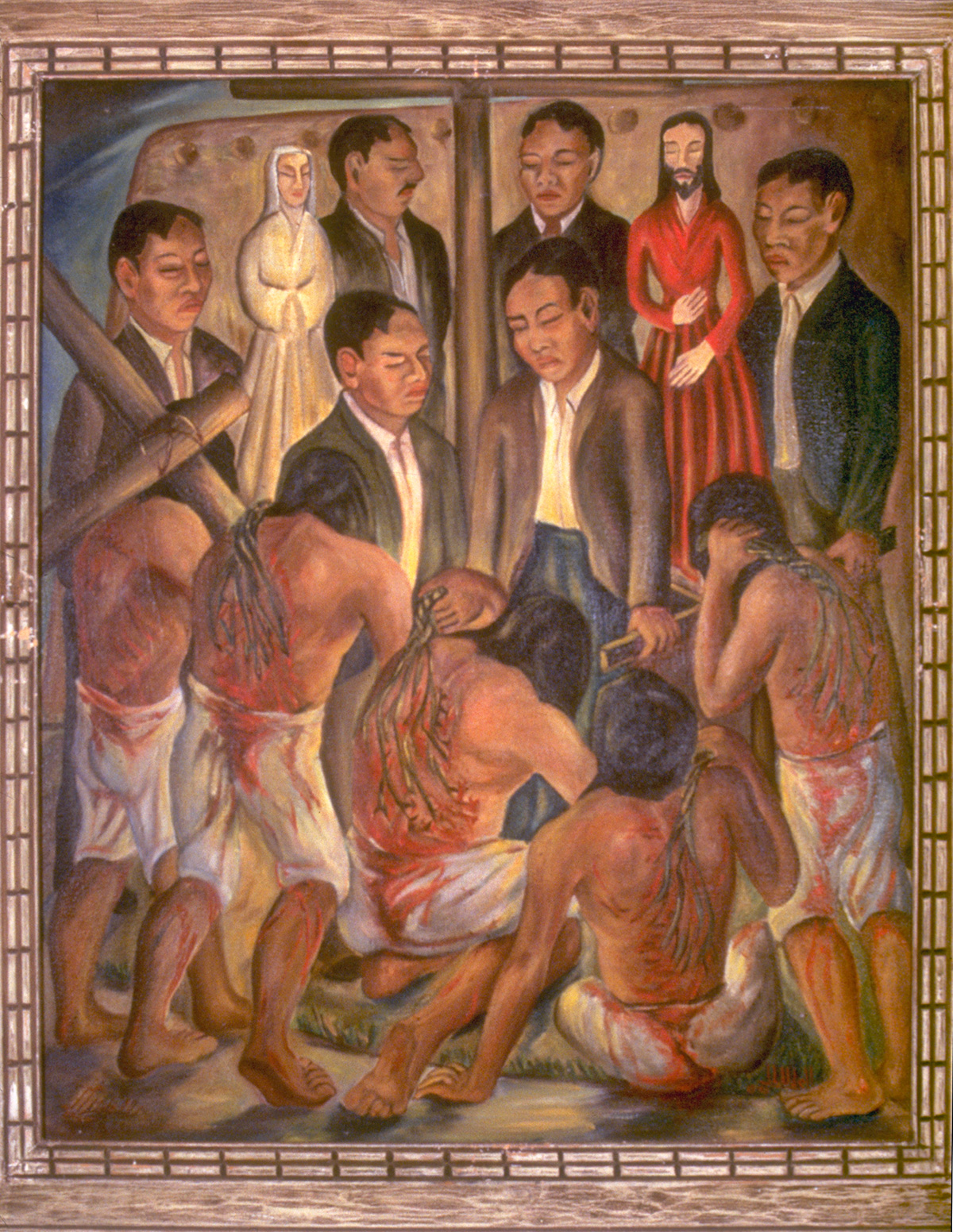
5. Penitentes Around the Cross Usually at the end of a procession those making the pilgrimage are met by another group in front of the Morada. Some of the members of this group carry nearly life-sized images of the Virgin and the Christ on platforms; the Virgin in pure white and the Christ in flaming red. Here hymns are sung and prayers said. Below is a typical chant translated from the Spanish.
“Penitence, Penitence
Sin no more, unfortunate man,
Examine your conscience,
Come to the temple and hear the voice.
It is time to make penance,
You who have been too busy
To take warning to repent
Examine your conscience.”
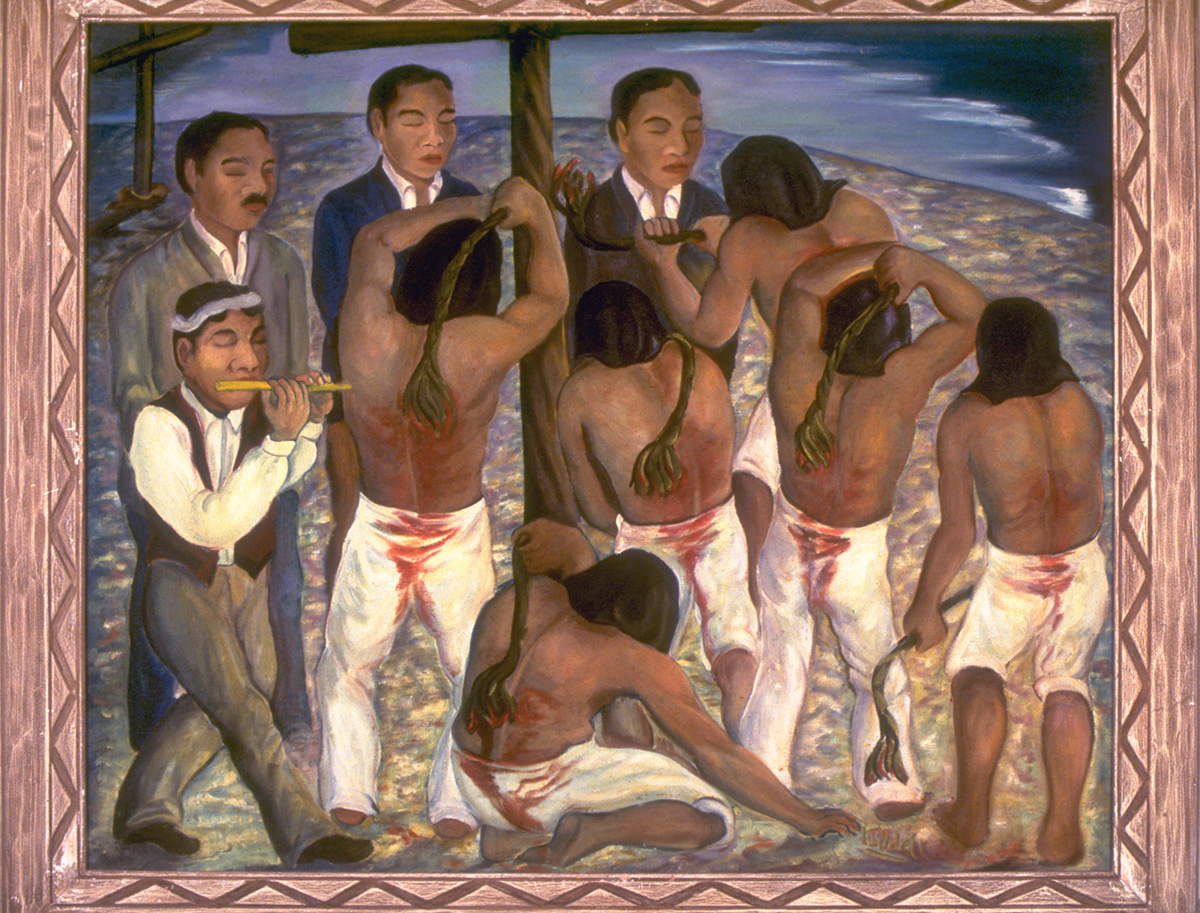
6. Whippers at Night The costume of the whippers is a pair of cotton drawers rolled up above the knees. Here the Penitents’ drawers are saturated with blood to their very ankles.
Their disciplinas, or whips, are made of the tough sharp-edged fibers of the yucca plant. They are three to three and a half feet long, braided at the handle and left to fall loose and fan-like at the end. They weigh from two to three pounds. The end which lacerates the back is often dipped in a solution called “romero,” a sort of herb tea which has salt added. Perhaps the salt increased the sting slightly, but too, it is mildly antiseptic. Often cactus is braided into the disciplinas: sometimes pieces of glass and wire hooks are added so that whipping aside from bruising penetrates and tears the flesh. The Penitent usually whips on each third step, alternately, over the right, then the left shoulder.
It is of record that some flagellants have laid upon themselves well over two thousand lashes in the course of one day.
Every member whips at least once after his initiation. He may whip more often, he may scourge himself every year or he may omit it some years. His ordeal will depend upon what his conscience dictates for his way of life during the past year.
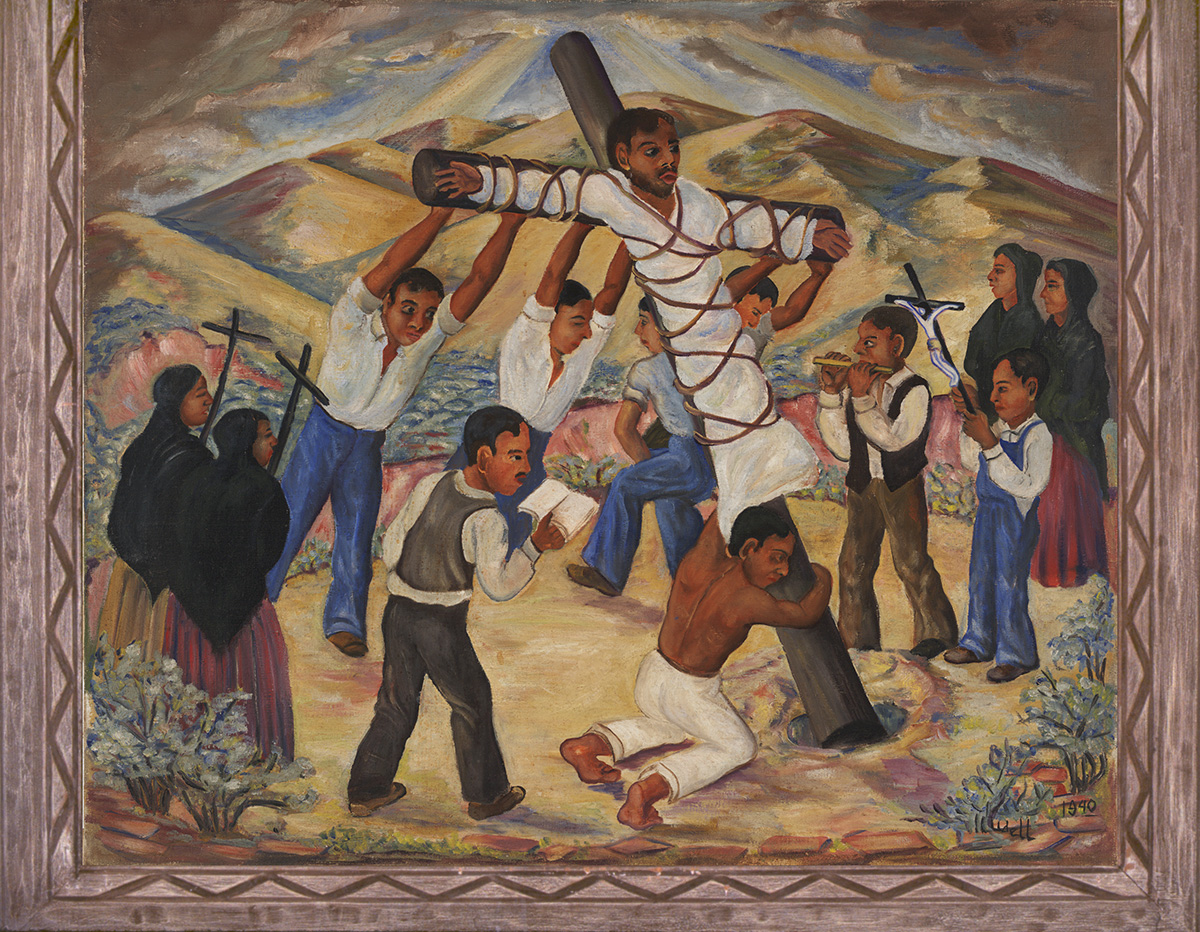
7. Raising the Cross The ritual of the crucifixion varies slightly in the presentation from year to year and in the various communities, although essentially it is the same. Here the crucifixion portrayed, is one of a small group of people closely related, almost a family affair, in an isolated community where members of the Brotherhood are not so numerous and cannot indulge a grand scale ceremony. The cross used is smaller and does not need to be steadied by guy-ropes as in the case of larger, taller crosses. The black head-bag or hood has been omitted because in small or family portrayals of the crucifixion, all members know one another and there is not a large gallery, hence, the secretiveness of the black hood is not necessary. The painting does not show how devoutly the Passion is re-enacted. Neither the circumstance of isolation, nor the lack of audience denies them their own particular deeply rooted conviction in their way to salvation.
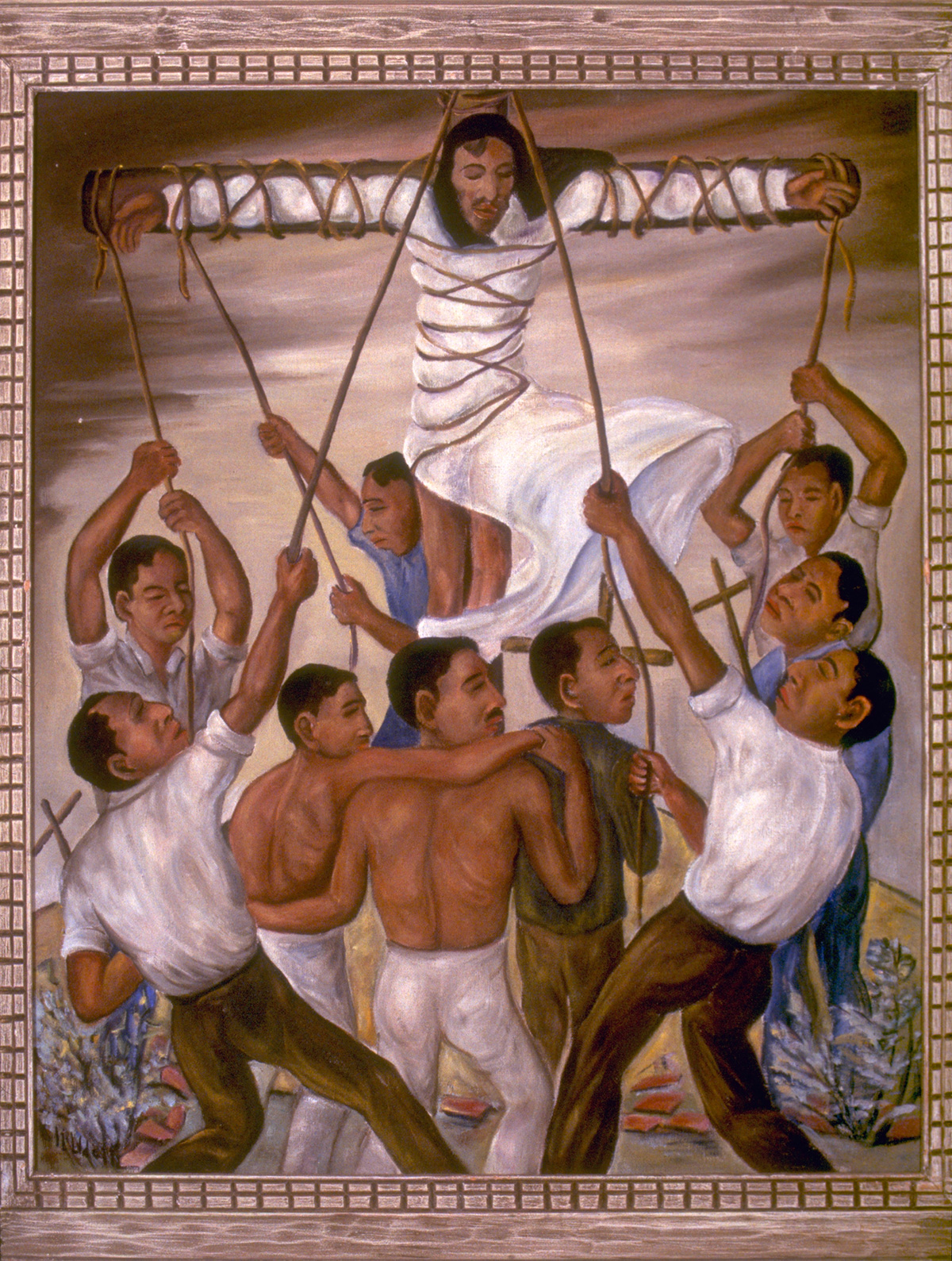
8. Penitente Crucifixion Crucifixion of one of the members is a regular occurrence and climaxes the activities of the Order until another Lenten season. Often only one crucifixion is held for several participating communities or neighboring villages. Such a crucifixion is usually off with more solemnity and exactness, and with greater drama. The chosen subject is bound to the cross while it is lying upon the ground. Many cry out to be nailed rather than tied, but in the last few years nailing has been abandoned. The subject securely bound, the cross is raised by lifting and pushing and with the aid of guy-ropes until it “chugs” into the hole dug for it. Men nailed to the cross have remained conscious for several hours: those bound remain conscious only a matter of minutes, since the circulation is so greatly impaired. Injury often occurs to the heart. When the man on the cross has lost consciousness the cross is lifted from the hole and lowered (often a lengthy process). The limp form is then unbound and carried to the Morada.
In earlier times the man who was to represent the Christ (usually a teen-aged boy) was chosen a few years in advance and was to lead an exemplary life until the time of his supreme ordeal came. Today, with pressure from church and state, and from education in regularly functioning schools few young men are found who will submit themselves to the exemplary life and to the crucifixion: the Christo now is usually chosen by lottery.
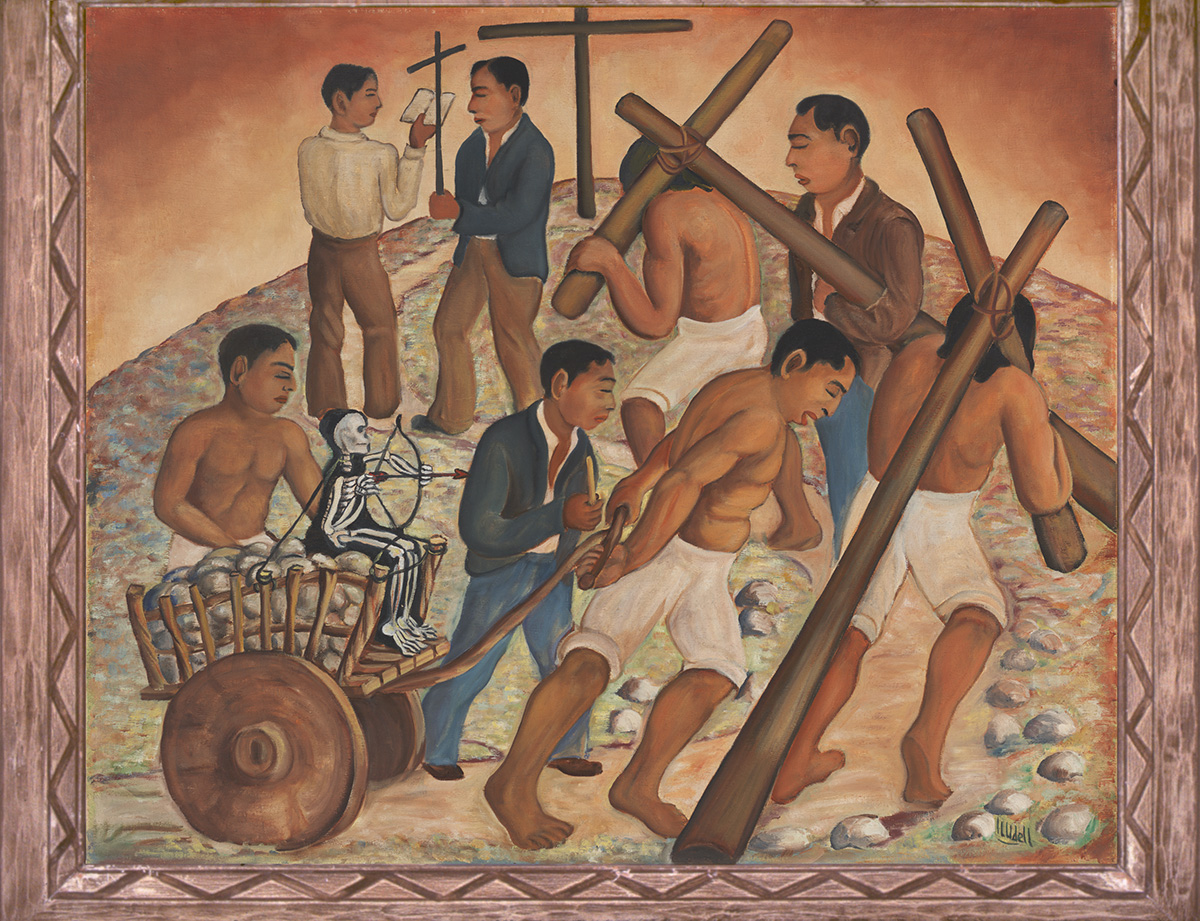
9. Procession with Carretta del Muerto In many processions the Carreta del Muerto, death cart, is dragged by one of the brothers. It is a wooden cart with solid hand-hewn wheels. More often than not is is loaded heavily with stones atop of which rides El Santo del Muerto, the Saint of Death, carved in the form of a skeleton, draped in black garments and carrying a bow, with a red tipped arrow.
Legend has it that once the arrow loosed itself from the bow and penetrated the heart of an unbeliever who mocked. The arrow remains poised to speed on its just mission should the occasion arise again. The death cart may be dragged for miles leaving a trail splotched with blood from the torn feet of the brother dragging it. Its origin and use in penitente processions is somewhat obscure, it does however, add much to the ordeal of penance.
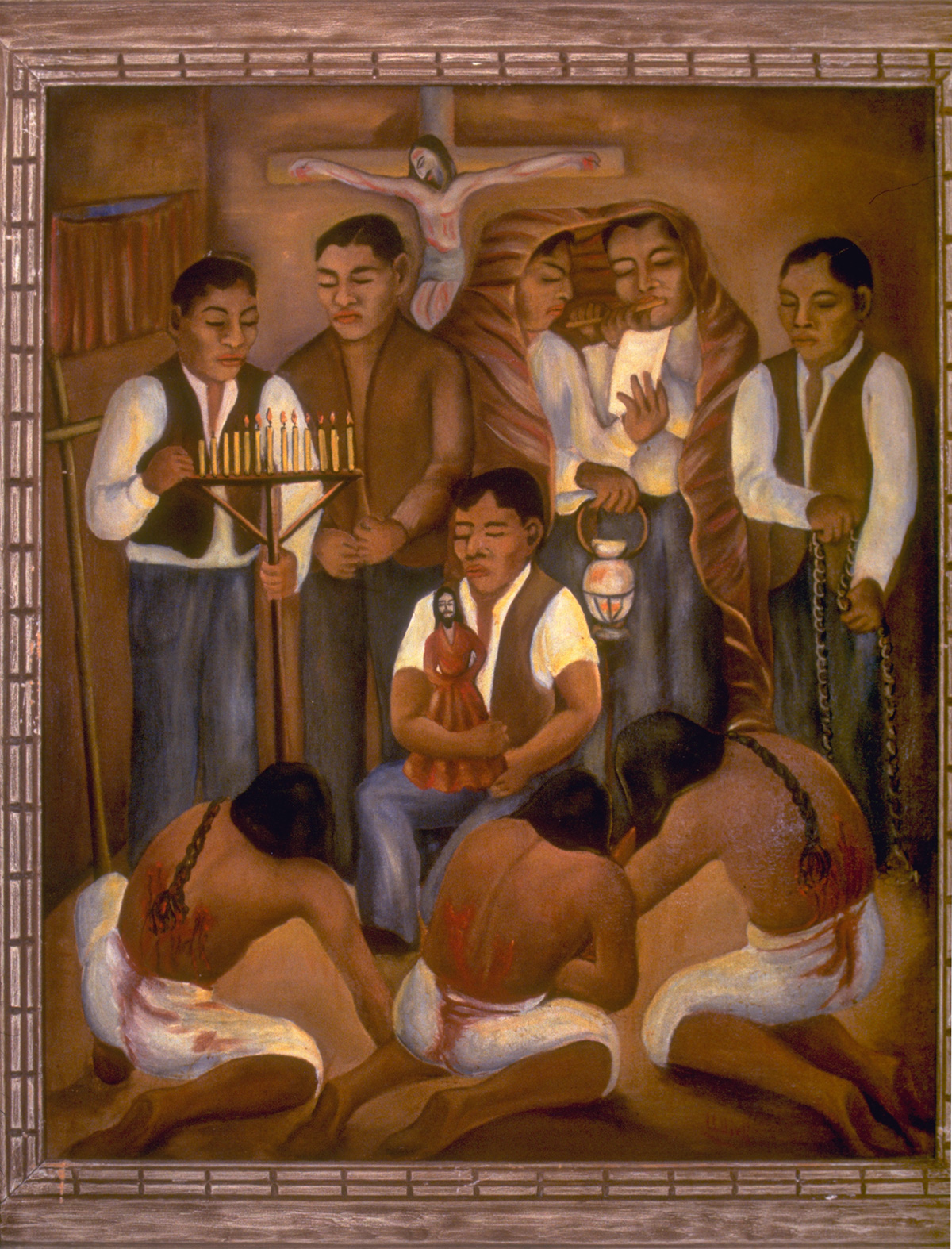
10. Tinieblas Tinieblas service takes place within the Morada. The brothers station themselves before an altar and about a candelabrum upon which are lighted candles (here a difference occurs, many times only twelve candles are used, one for each disciple: when thirteen are used they represent the stations of the cross). One by one the candles are snuffed out, and as the room becomes dark the Rezador and Pitero pull the blanket completely about them so that light from their lantern does not show into the darkened room. The lantern is necessary that they may see to read the ritual which is too long to be memorized. When the room is totally dark, chains are rattled, shrieks pierce the quiet, and general pandemonium breaks loose: such is the representation of the earthquake and storm after the crucifixion of Christ, when the graves yielded up their dead and when the wailings of souls in torment were heard.
Once the service has begun no one leaves. It may last a little time or hours. The air is stifling from the close-packed sweating bodies; the smell of blood is heavy and oppressive; the swish and thud of the whips punctuate moments of silence. Such is Tinieblas.
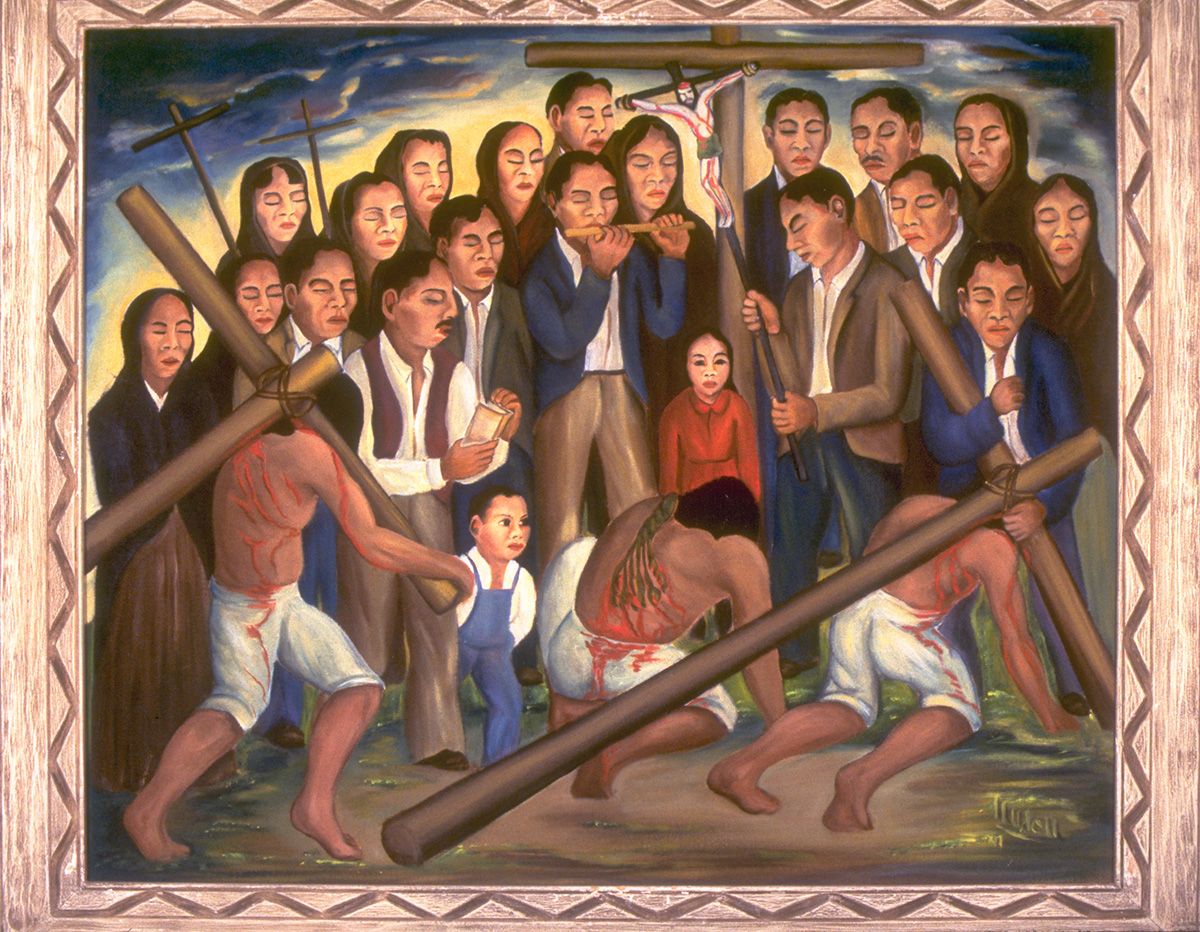
11. Procession with Gallery Here is pictured another version of a typical procession with Hermano Mayor, Pitero, Rezador, cross-bearers, and whippers followed by a gallery of men, women, and children. The religious impulse is individual, is family, is universal. Although the women receive no of- ficial credit, and are not acknowledged in any way as part of drama enacted, they often walk miles with beans in their shoes, or walk with strands of barbed wire bound tightly about their thighs. During the days that the men are occupied in the Morada with things religious the women are in waiting upon them, bringing them food and drink.
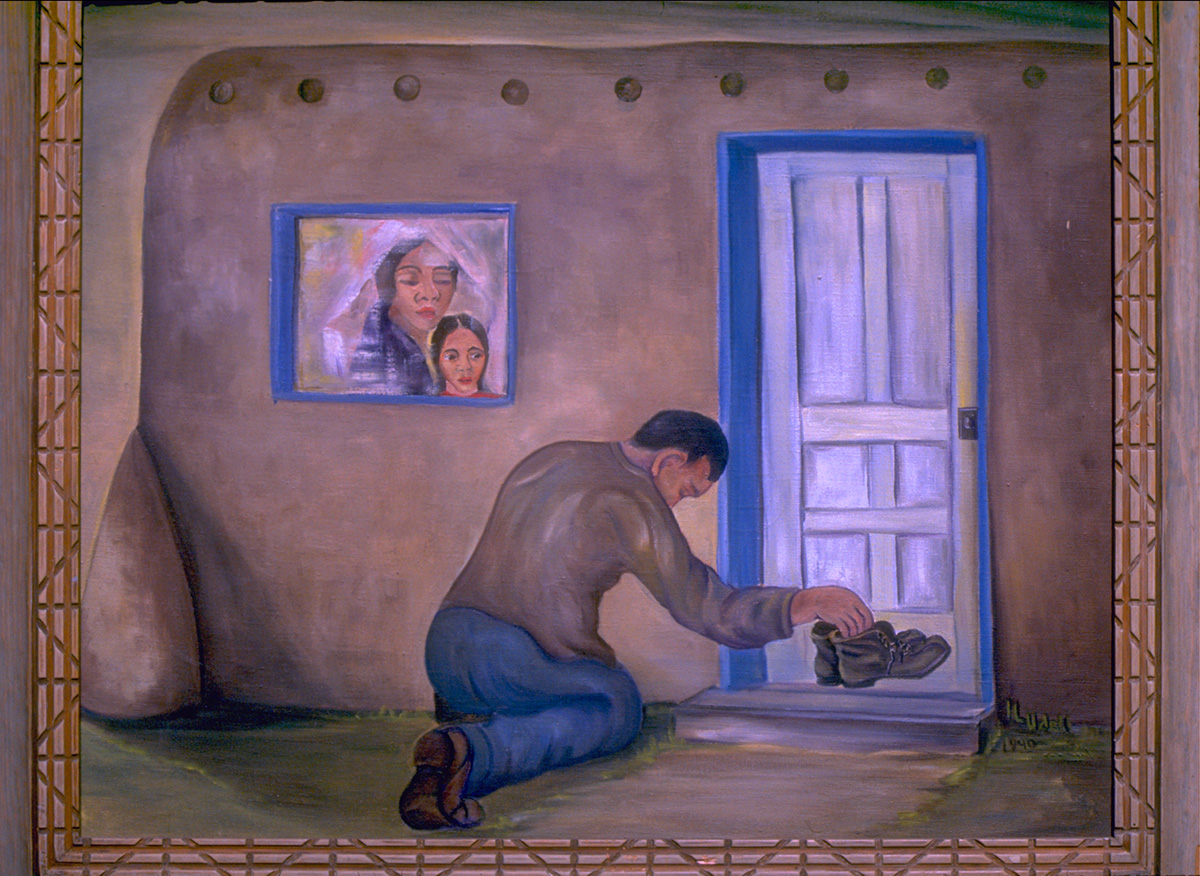
12. Death Came During Penance The painting above portrays a tensely dramatic moment, that of announcing death during penance of a brother. The announcement is made by leaving some article of the deceased’s clothing, usually his shoes, upon his door-step. This is the only notice of his death or admission of it. An occasional death occurs from loss of blood, exposure, and pneumonia, especially in a season when there is raw cold winds or late sleet and snow.
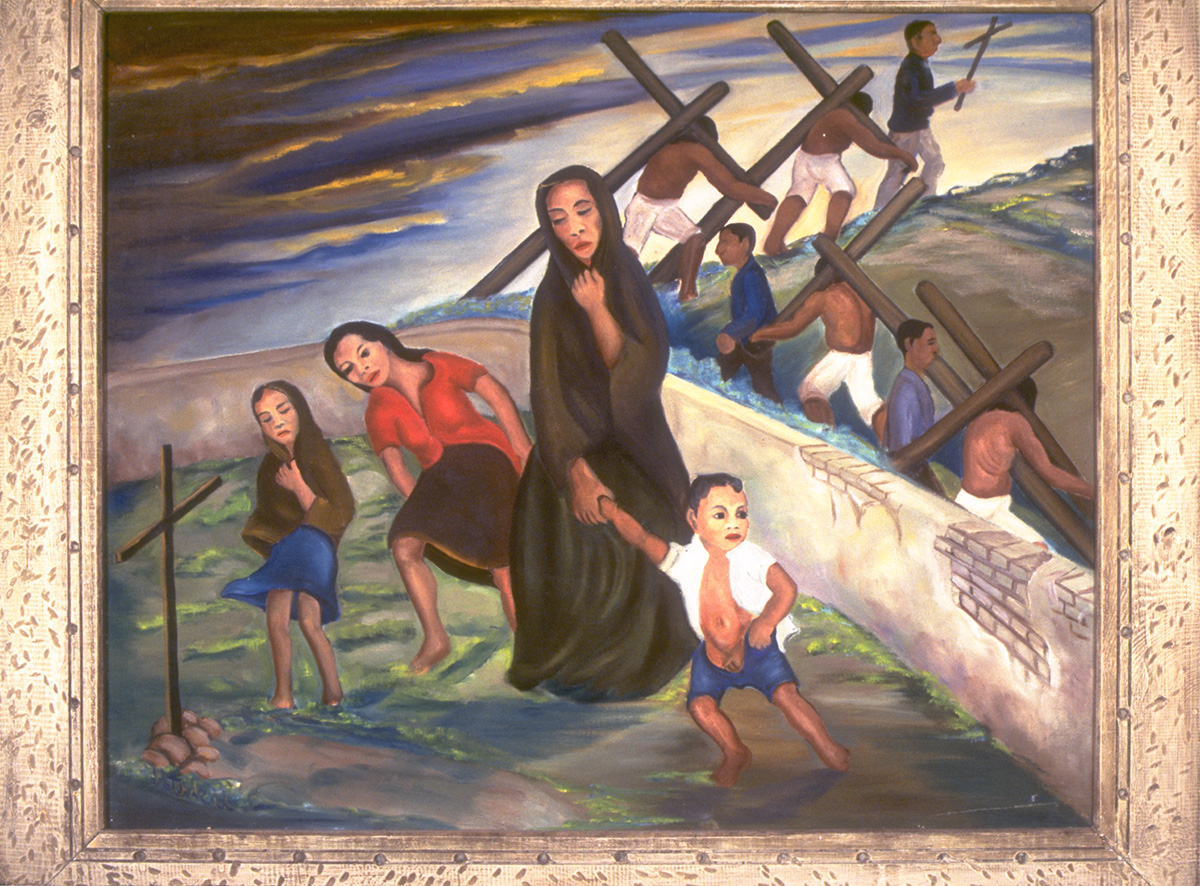
13. The Last Cross The Last Cross—does not show any particular ceremony or ritual. It pictures a corner of an adobe-walled grave yard—with a fresh grave where one of the Penitents has been buried. The family has learned of the death and is at the grave as the procession of brothers leaves the scene.
Need for this painting was felt much as a writer feels the need for a concluding paragraph. It is one of the few instances in the series where the artist has taken the liberty of personal statement.
